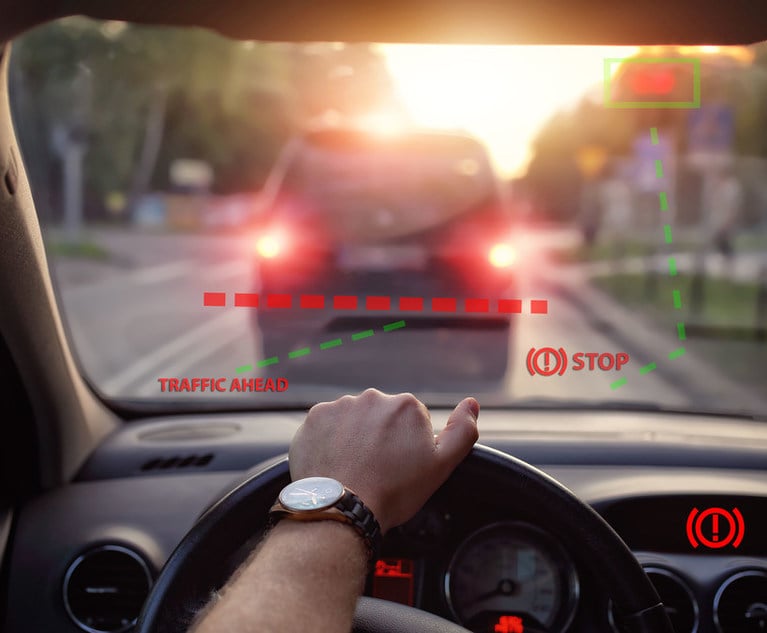One sunny spring morning, on a rural road just outside ofHouston, Texas, Molly Jackson, a vibrant 16-year-old girl with abright future and a new driver's license, was behind the wheel ofher father's brand new Chevrolet C2500 crew cab pickup truck. Atthe same time, just seven seconds before she would draw her lastbreath, Rhonda Simmons, a 46-year old divorced mother of twoteenagers, was approaching from the opposite direction in her sleekand sporty Pontiac Trans Am.
|The freshly paved, two-lane county road with a 55-mph speedlimit was so newly resurfaced that fog lines delineating the edgeof the pavement had not yet been painted. The center of the roadwas designated only by small, reflective yellow tabs, spaced 10feet apart. Neither Simmons nor Jackson could foresee how theirlives would change forever in mere seconds — one leaving this earthand the other, living with the burden of another person's death andfacing criminal indictment.
|What Went Wrong?
|Just five seconds before their two worlds collided, theright-side tires of the big Chevy dropped off the pavement and ontothe grassy shoulder. At 55 mph, the pickup was a little more than400 feet from the very point on earth where the two lives would beirreversibly changed, yet Jackson only had five seconds to regaincontrol of the vehicle. Partly because of her inexperience andpartly due to the fact that the drop on the right side was muchgreater than she expected, Jackson struggled to steer the vehicleback onto the paved surface.
|As both drivers approached a slight S-curve, Jackson steeredhard to the left, putting the Chevy into a yaw from which she wouldnot recover. The big truck popped back up on the pavement, crossedthe center point on the road, and struck Simmons' Trans Am withmore than 578,000 ft-lbs of kinetic energy. The vehicles engaged inhorrific fashion, began to rotate in a clock-wise fashion, and thenseparated. The Trans Am was no match for the rugged and rigidChevrolet. It crushed so much that the driver's compartment aroundSimmons disappeared. Although the airbags deployed, the steeringwheel was thrust rearward to the point of almost touching thedriver's seat, causing Simmon's torso to absorb the full force ofthe airbag.
||An investigation ensued, but the sheriff's department lacked theequipment or technical expertise to conduct a thorough crashreconstruction. However, they knew enough to be dangerous. One ofthe investigating officers remembered from a seminar that a yawmark could be measured and variables plugged into a formula todetermine a vehicle's speed. Armed with this knowledge,investigating officers measured what they believed were yaw marksfrom the Chevrolet and determined that Jackson's vehicle wastraveling about 82 mph when she steered it suddenly and created themark.
|Sheriff's investigators failed to recognize that the damage,although extensive, was not to the extent one would expect if a3-ton pickup struck a passenger car at 82 mph. Even moredisturbing, they made no measurements of the impact point andpoints of rest, nor did they download impact crash data residingwithin the event data recorder (EDR) of the airbag control modulesof both vehicles.
|Technology Yields New Clues
|Since 2000, Vetronix Corporation has manufactured a crash dataretrieval (CDR) system that is available to law-enforcement,industry, and crash-reconstruction experts. It provides the userwith an interface to gain access to the EDR of some Ford, Isuzu,Lincoln-Mercury, and many General Motors and Saturn vehicles. Inthe case of General Motors and Saturn, some model years as old as1994 have data stored on the EDR.
|With the Vetronix CDR, data retrieval can be accomplished infive-to-10 minutes, assuming the EDR is accessible. The CDRconverts hexadecimal codes into useable data and displays it in adecipherable format on a Windows-based PC.
||W.R. “Rusty” Haight, founder and director of the CollisionSafety Institute in San Diego, Calif., said that EDR technology hasimproved and has lead to improvements in three key areas of trafficsafety: engineering, education, and enforcement. Haight believesthat this technology has and will continue to save lives. Accordingto him, since the technology became mainstream in 2000, there havebeen recalls as well as less-significant changes in vehicle design,changes in driver behavior, and a whole gamut of traffic-safetyimprovements. However, he cautions that the room for error andmisinterpretation is greater than ever.
|Although the data can be instrumental in reconstructing a crash,it can be misleading or wrong if it is relied upon as a stand-alonedata point. Insurance companies can make better claim decisions andreduce claim costs if the data is used as intended — as a tool tobe used in combination with a thorough crash reconstruction.
|The EDR data should supplement the information documented inphotos, damage-repair estimates, scene evidence, law-enforcementreports, and witnesses' accounts in order to determine liabilityor, in some cases, to help determine whether the collisionmagnitude was severe enough to cause occupant injury in alow-velocity crash.
|“The data … is what it is, no different than a skid mark is askid mark,” Haight said. “How it can and when it can't be used is asecond issue and one that needs to be addressed throughunderstanding, proper training, and proper application of thetechnology.”
|Results of the Reconstruction
|In the case of Jackson and Simmons, the data harvested from thewreckage of both vehicles told a story that was very different thanthe results of the sheriff's investigation.
||First, the EDR in the Chevrolet pickup stored five seconds ofpre-crash data that included vehicle speed, engine RPM,brake-switch position, and percent-of-throttle input. At no time inthe five seconds preceding the crash did the speed of the Chevroletpickup exceed 65 mph. Yet the sheriff's department erroneouslycalculated the speed to be 82 mph as the truck began to yaw. Infact, the last recorded speed of the Chevrolet pickup was 58mph.
|The EDR also recorded a maximum change in velocity, or delta-V,of -25.9 mph and indicated that Jackson was wearing her seatbelt.The EDR in the Pontiac Trans Am also recorded some crucial data,although it was not as extensive as the Chevrolet pickup. There wasno pre-crash data, but the maximum recorded delta-V was -39.8mph.
|The electrical system on the Pontiac was severely compromised,forcing a more cautious analysis of the stored data. For example,the data summary indicated that Simmons was not wearing herseatbelt at the time of the collision. The inspection of thevehicle during reconstruction revealed, however, that the driver'sseatbelt latch plate was still inserted into the buckle and thebelt was cut in two places by rescuers who worked to free Simmonsfrom the wreckage. Because of the damage to the electrical system,all of the data could not be written to the EDR and the systeminterpreted the results for the driver seatbelt as beingunbuckled.
|Using all of the information collected from both EDRs inconjunction with the crash reconstruction yielded a much differentcrash scenario than the one the sheriff's investigators haddeveloped. The calculated impact speed of the Chevrolet C2500 was58 mph, yielding a calculated change in velocity of -24 mph. Thecalculated impact speed of the Pontiac Trans Am was 55 mph, with acalculated change in velocity of -39.8 mph. The EDR data yielded achange in velocity of -25.29 mph for the Chevrolet pickup and-39.05 mph for the Trans Am. The calculated changes in velocitydiffered from the stored data by 1.34 mph on the Chevy and a mere.75 mph for the Pontiac.
|The crash reconstruction and the data retrieved from thevehicles were in agreement. The calculations performed by thesheriff's department did not consider any of the physical evidenceavailable at the scene, other than the yaw mark. Further, theirinvestigation did not consider the data stored by the EDR in eithervehicle. Thus, their hypothesis was inaccurate and theirpresentation of the criminal case to the district attorney's officewas based on erroneous calculations.
||Jackson may be found liable in a civil lawsuit, but she wasspared from criminal prosecution after a thorough crashreconstruction, partially based upon data retrieved from the EDR ofeach vehicle, was presented in total to the district attorney'soffice. The crash was a tragedy for all parties involved, but thetragedy could have been further compounded by a faulty policeinvestigation that did not include readily available crashdata.
|Future of EDR
|As long as safety advances continue to be made, an increase inthe use of the technology will continue as well. Down the road,Haight said, we are likely to see other related innovations forboth fleet management and individual applications. Tying in othervehicle systems, including diagnostic tools, is the next logicalnext step. Haight believes that analytical computer programsalready in use will be modified to include data from in-car systemsfor better, more rounded analyses.
|Finally, Haight offered a bold vision for the automotive andinsurance industries, who typically find themselves on oppositesides of an argument in the area of design improvements.
|“I anticipate insurance companies [will offer] discounts fordrivers of cars with accessible systems and while that wouldrequire a huge leap forward with the auto manufacturers, it's awin-win position for both,” he said.
|The results of a thorough crash reconstruction, combined with ananalysis of the EDR data, will yield a more accurate crashreconstruction. It also demonstrates that while the technology isbeneficial, it should be used as a tool in the complete crashreconstruction toolbox and not as a stand-alone data point. Aspublic awareness of the technology grows, other manufacturerslikely will follow the lead of General Motors and Ford and make thedata more accessible for use in crash reconstruction and othersafety-related applications.
|Billy S. Cox, Jr. is a senior transportation forensicconsultant at EFI Global, Inc. in Kingwood, Texas. Mr. Cox can becontacted via email at [email protected] or by phone at979-260-2010.
Want to continue reading?
Become a Free PropertyCasualty360 Digital Reader
Your access to unlimited PropertyCasualty360 content isn’t changing.
Once you are an ALM digital member, you’ll receive:
- All PropertyCasualty360.com news coverage, best practices, and in-depth analysis.
- Educational webcasts, resources from industry leaders, and informative newsletters.
- Other award-winning websites including BenefitsPRO.com and ThinkAdvisor.com.
Already have an account? Sign In
© 2024 ALM Global, LLC, All Rights Reserved. Request academic re-use from www.copyright.com. All other uses, submit a request to [email protected]. For more information visit Asset & Logo Licensing.








